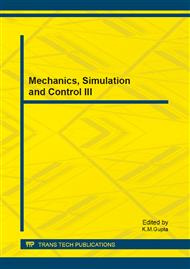p.253
p.259
p.264
p.270
p.275
p.280
p.286
p.292
p.297
A Multiscale Finite Element Simulation of Human Aortic Heart Valve
Abstract:
Some of the heart valve diseases can be treated by surgical replacement with either a mechanical or bioprosthetic heart valve (BHV). Recently, tissue-engineered heart valves (TEHVs) have been proposed to be the ultimate solution for treating valvular heart disease. In order to improve the durability and design of artificial heart valves, recent studies have focused on quantifying the biomechanical interaction between the organ, tissue, and cellular –level components in native heart valves. Such data is considered fundamental to designing improved BHVs. Mechanical communication from the larger scales affects active biomechanical processes. For instance any organ-scale motion deforms the tissue, which in turn deforms the interstitial cells (ICs). Therefore, a multiscale solution is required to study the behavior of human aortic valve and to predict local cell deformations. The proposed multiscale finite element approach takes into account large deformations and nonlinear anisotropic hyperelastic material models. In this simulation, the organ scale motion is computed, from which the tissue scale deformation will be extracted. Similarly, the tissue deformation will be transformed into the cell scale. Finally, each simulation is verified against a number of experimental measures.
Info:
Periodical:
Pages:
275-279
Citation:
Online since:
August 2013
Authors:
Price:
Сopyright:
© 2013 Trans Tech Publications Ltd. All Rights Reserved
Share:
Citation:


